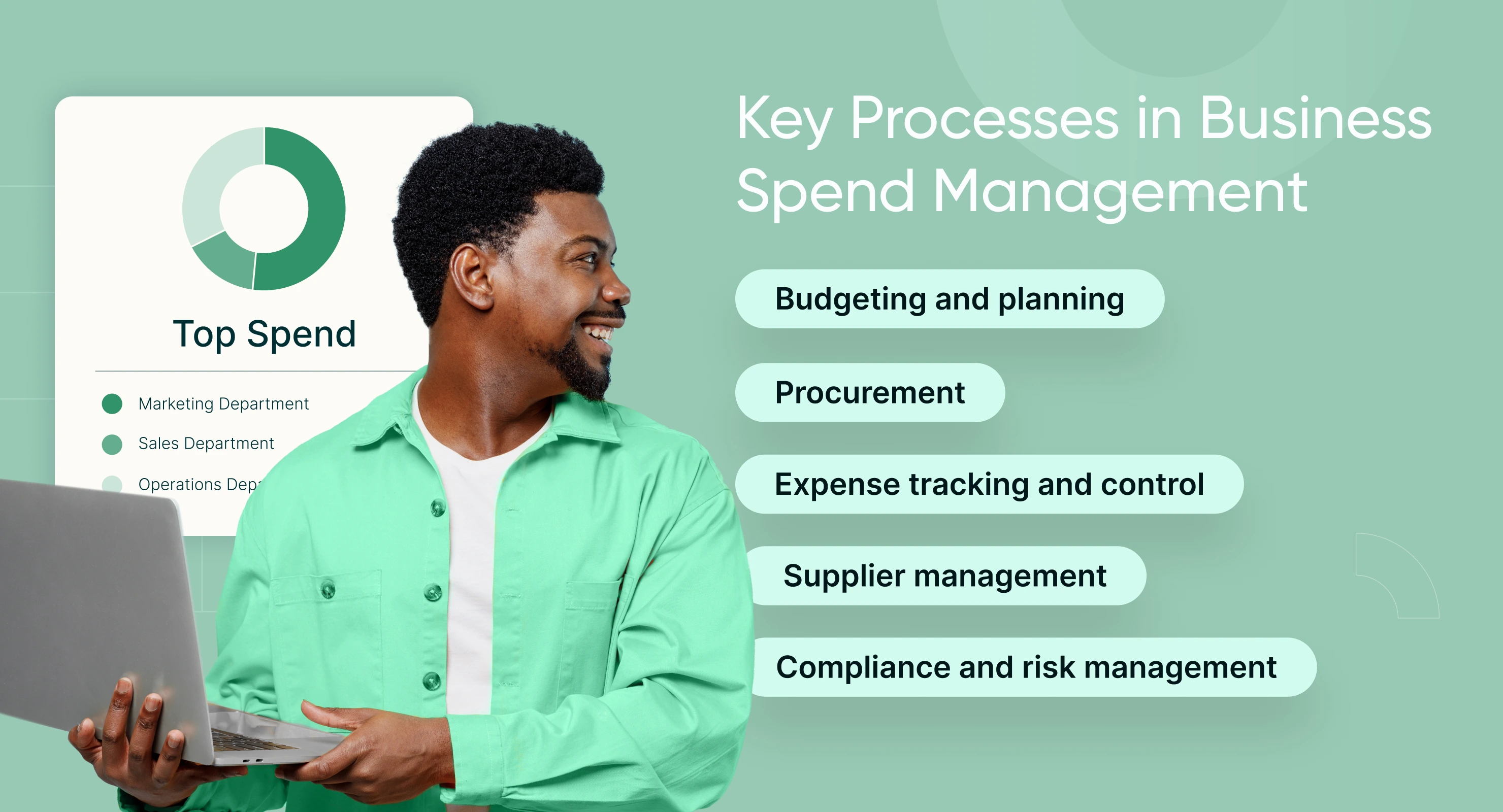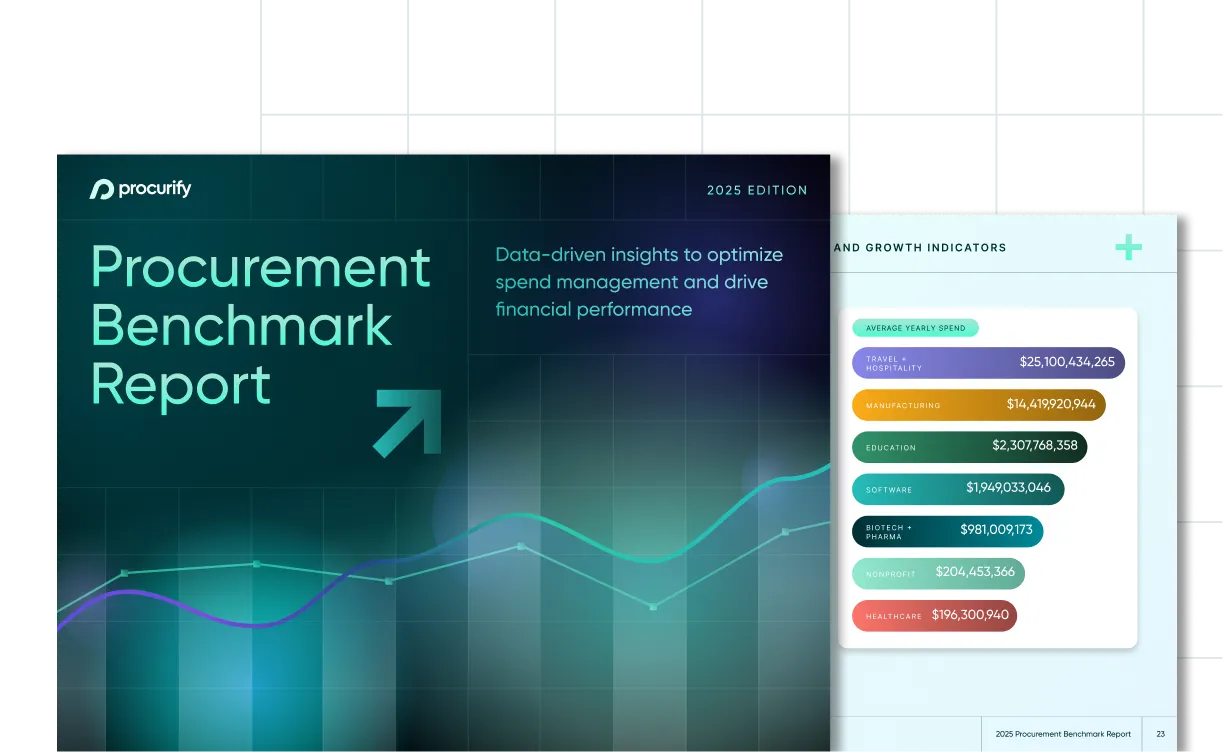
What Is Spend Management: Key Processes and Trends in 2025
Corporate budgeting 101: Every dollar you spend should align with your strategic business goals.
Fundamentally, spend management refers to the process of controlling and optimizing a company’s expenditures. It encompasses various functions aimed at improving financial oversight and operational efficiency, including:
-
Procurement
-
Expense management
-
Supplier management
-
Compliance
Spend management involves tracking and analyzing all forms of business spending. This includes day-to-day operational expenses, purchases of goods and services, and employee-related costs, such as travel and entertainment. By having a comprehensive view of where money is going, businesses can identify inefficiencies, eliminate waste, and make informed decisions that drive cost savings and productivity.
Spend management also plays a crucial role in aligning financial practices with broader business strategies. For example, businesses can use spend management tools to enforce company-wide spending policies, ensure that budgets are adhered to, and negotiate better deals with suppliers. This creates a more streamlined and effective procurement process, leading to stronger financial health and long-term success.

Take control of spend
Book a personalized demo to see how Procurify makes it super easy for businesses to manage spend and save millions in time and money.
In today’s digital world, modern spend management solutions often integrate advanced technologies, such as automation, AI-powered analytics, and real-time expense tracking, which allow businesses to manage spending proactively. These technologies provide real-time data, ensuring that business leaders have the insights needed to optimize spending and reduce costs.
The importance of business spend management
Effective spend management is essential for maintaining financial health and operational efficiency. Without a structured system for managing expenses, businesses risk overspending, non-compliance with regulations, and a lack of transparency across departments.
One of the primary reasons spend management is critical is its ability to provide real-time visibility into where money is being spent. With clear insights, businesses can ensure that expenditures are aligned with budgets and company objectives. This visibility allows companies to prevent maverick spending—unapproved purchases that often lead to budget overruns—and ensures that all spending follows set guidelines.
Spend management also helps businesses reduce costs by identifying savings opportunities. By centralizing and analyzing all procurement data, companies can negotiate better terms with suppliers, avoid duplicate purchases, and take advantage of early payment discounts.
Another critical aspect is compliance and risk management. This is particularly important for businesses operating in regulated industries where procurement and financial practices must meet strict standards. Spend management systems enforce internal policies and track spending to ensure compliance with regulations, helping companies avoid costly penalties.
Lastly, spend management fosters operational efficiency by automating time-consuming tasks like invoice processing and approval workflows. By eliminating manual processes, companies can reduce errors and free up employees to focus on more strategic, value-added activities.
Key processes in business spend management

Effective business spend management consists of several key processes that work together to ensure that spending is optimized, aligned with company goals, and managed efficiently. Each process plays a critical role in ensuring that a business can control its costs while maintaining operational efficiency.
-
Budgeting and planning
The foundation of any spend management system is a solid budgeting and planning process. Businesses set financial targets and allocate resources to specific departments or projects based on strategic objectives. This process involves setting spending limits and forecasting future expenses, ensuring that actual expenditures stay within budget.
When businesses have clear spending guidelines in place, they can make more informed decisions about where to allocate funds and how to manage costs.
-
Procurement
Procurement is a crucial component of spend management. It involves acquiring goods and services from vendors in a way that maximizes value for the company. This process includes everything from sourcing suppliers, negotiating contracts, and making purchasing decisions. The goal is to secure competitive pricing while maintaining the quality of goods and services. Efficient procurement processes ensure that businesses get the most value for their money, and they help to prevent unnecessary or duplicate purchases.
-
Expense tracking and control
Monitoring expenses in real-time is essential for effective spend management. Real-time tracking allows businesses to identify areas where they may be overspending and to ensure that all spending is within approved budgets. Expense control measures, such as automated approval workflows, help prevent unauthorized expenditures and ensure compliance with company policies.
By continuously tracking spending, businesses can quickly detect potential issues and make adjustments before they become larger problems.
-
Supplier management
Building and maintaining strong relationships with suppliers is another important aspect of business spend management. Supplier management involves selecting vendors, negotiating favorable terms, and managing contracts to ensure that the company gets the best possible deal. It also includes evaluating supplier performance to ensure that they consistently meet the company’s standards for quality, delivery, and cost.
Strong supplier relationships lead to better pricing, more reliable service, and less risk of supply chain disruptions.
-
Compliance and risk management
Ensuring compliance with both internal policies and external regulations is a critical component of spend management. Businesses must track spending to ensure that they are meeting legal requirements, such as tax regulations and procurement laws. Additionally, effective spend management helps mitigate risks associated with fraud, maverick spending, and non-compliance.
Automated systems can flag potential issues and ensure that all expenditures are authorized and properly documented.
Spend management tools and technologies
Modern spend management is increasingly powered by advanced technologies designed to streamline processes, provide real-time data, and reduce manual effort. These tools help businesses manage their expenditures more efficiently, ensuring greater accuracy, better decision-making, and cost savings across the organization.
-
Automation
Automation is one of the key technological advances in spend management. By automating tasks such as invoice processing, expense approvals, and reporting, businesses can significantly reduce the time and effort required for manual data entry. This not only minimizes errors but also ensures that processes are consistent and compliant with company policies. For example, automated workflows can flag expenses that require approval or alert teams to potential budget overruns before they occur.
-
AI-powered analytics
Artificial Intelligence (AI) is increasingly being integrated into spend management systems to help businesses analyze spending patterns and identify trends. AI-powered procurement analytics can detect anomalies, such as potential fraud or inefficiencies in supplier contracts, and suggest optimizations based on real-time data. By leveraging AI, businesses can gain deeper insights into their spending and make more strategic decisions.
-
Real-time tracking and visibility
Spend management tools provide real-time visibility into company-wide spending. This allows businesses to track expenditures as they happen, giving finance teams the ability to intervene quickly when necessary. Real-time data is especially important for making informed decisions during procurement and budgeting processes, ensuring that spending stays on track and within the company’s goals.
-
Integration with existing systems
Many spend management solutions are designed to integrate seamlessly with other enterprise systems, such as Enterprise Resource Planning (ERP) or accounting software. This integration ensures that data flows smoothly across all financial platforms, providing a single source of truth for company spending. These integrations can also enhance the capabilities of spend management tools, allowing businesses to automate additional processes and gain deeper insights into their financial data.
-
Mobile and cloud solutions
As businesses continue to operate in more mobile and remote environments, cloud-based spend management tools have become essential. A mobile procurement app allows employees to submit expenses, manage approvals, and track spending from anywhere, ensuring that workflows are not interrupted by location or device constraints. Additionally, cloud-based tools provide businesses with scalability and flexibility, allowing them to grow and adapt their systems as needed.
Frequently asked questions (FAQs)
Conclusion
Companies that adopt robust spend management practices are better equipped to respond to market changes, improve supplier relationships, and make informed, data-driven decisions.
Spend management is an essential part of any business strategy, providing the visibility and control necessary to optimize expenditures, streamline operations, and ensure long-term financial health. By implementing effective spend management processes businesses can reduce costs, minimize risks, and improve overall operational efficiency.

2025 Procurement Benchmark Report
Powered by $20B+ in proprietary data you won’t find anywhere else.
